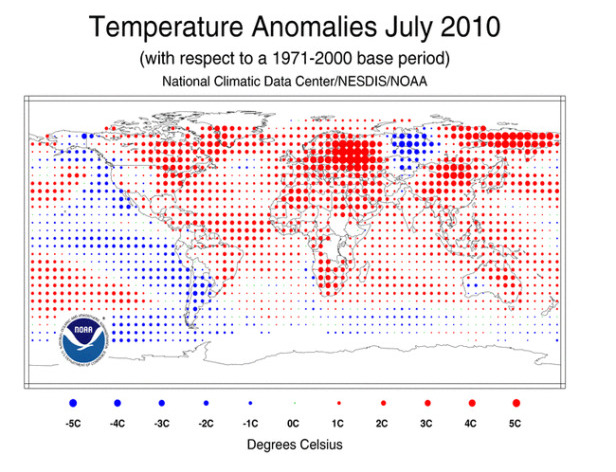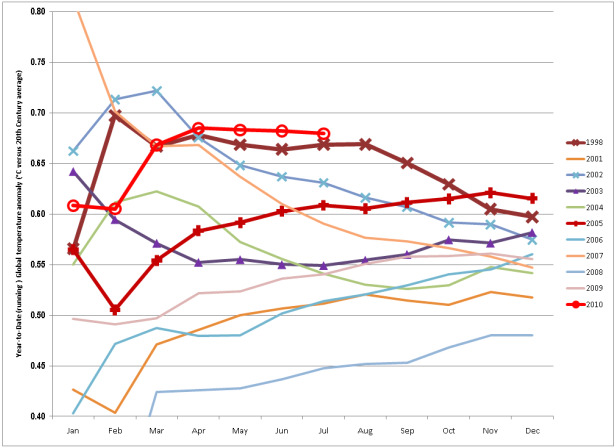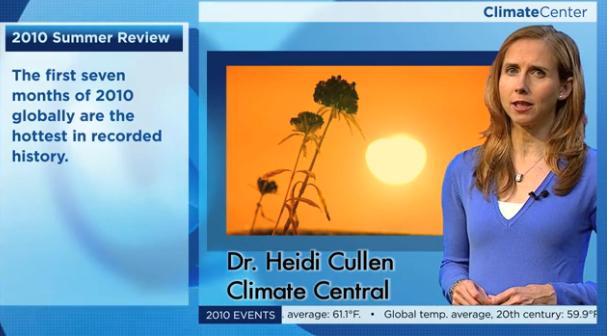After a scorching summer thus far, this year remains on track to be one of the hottest on record, according to the latest analysis from the National Oceanic and Atmospheric Administration’s (NOAA) National Climatic Data Center. The global land and ocean surface temperature data show that this July was the second warmest on record, and the period of January-July was the hottest since records began in the 1880s.
The combined global land and surface temperature for July came in at 61.6 degrees F, more than a degree warmer than the 20th century average, and only 0.1 degree F cooler than the warmest July on record, set in 1998. For land surface temperatures alone, it was the warmest July on record. The warmer-than-average global temperatures seen this year to date suggest 2010 could go into the history books as either the warmest, or at least one of the warmest, years on record.
 Temperature departures from average for the period from January to July 2010.Map: NOAA
Temperature departures from average for the period from January to July 2010.Map: NOAA
According to one relevant measure, it already has. According to NASA’s Goddard Institute for Space Studies, “The 12-month running mean of global temperature achieved a record high level during the past few months.” NASA’s analysis of global surface temperatures is in close agreement with NOAA’s data, finding that July was the fifth-warmest month on record, with the warmest January to July period.
The exceptionally warm global temperatures seen through the first part of 2010 were maintained in July in spite of the presence of La Nina. which has brought cooler than average sea surface temperatures to the tropical Pacific. As La Nina continues through the second half of 2010, it could cool global average surface temperatures just enough to prevent this year from eclipsing 1998 as the hottest year since instrumental records began.
 A comparison of year-to-date global temperature anomaly (in degrees Celsius) for some of the warmest years on record, including 2010 so far. Chart: NOAA
A comparison of year-to-date global temperature anomaly (in degrees Celsius) for some of the warmest years on record, including 2010 so far. Chart: NOAA
So far this year, 17 countries have set new national records for warmest-ever recorded temperatures, including Finland, Belarus, Columbia, Russia, Saudi Arabia, and Pakistan, which saw the mercury rise to 128.3 degrees F on May 26. If verified, Pakistan’s record would stand as the warmest temperature on record in the continent of Asia.
NOAA’s report of global July temperatures was released just over a week after a similar report of U.S. national temperatures for July was made public. The U.S. also experienced above average temperatures last month, and it was ranked as the 17th warmest July on record for the country. The states of Delaware and Rhode Island, as well as a number of cities across the East Coast, experienced their hottest ever month during July, although some western regions of the country experienced below average July temperatures.
The release of the July and year-to-date information also comes in the midst of a number of extreme weather events occurring around the planet. In particular, the ongoing heat wave in Western Russia and the floods in Pakistan brought on by unusually intense monsoonal rainfall. Though these extreme weather events cannot be solely attributed to the climate’s long-term warming trend, studies show that the warming climate increases the odds of such extreme events.
“What we can say is that global warming has an effect on the probability and intensity of extreme events,” says the NASA press release. “This is true for precipitation as well as temperature, because the amount of water vapor that the air carries is a strong function of temperature.”
How weather patterns play out through the rest of the year remains to be seen. As evident in the comparison of the planet’s 10 warmest recorded years, however, 2010 is off to a remarkably warm start.



